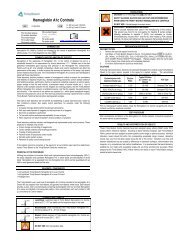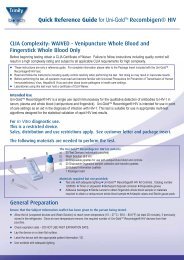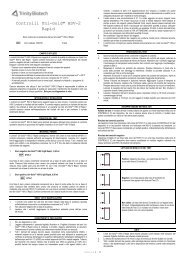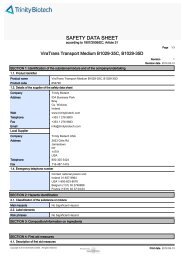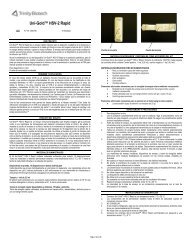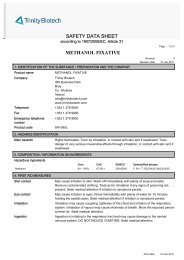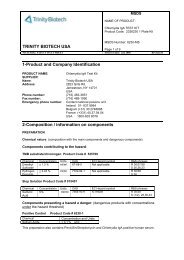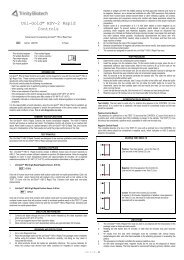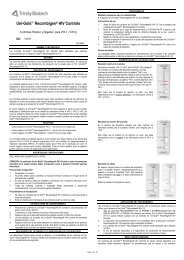Pack Insert - Trinity Biotech PLC
Pack Insert - Trinity Biotech PLC
Pack Insert - Trinity Biotech PLC
Create successful ePaper yourself
Turn your PDF publications into a flip-book with our unique Google optimized e-Paper software.
Pour d'autres langues<br />
Für andere Sprachen<br />
Para otras lenguas<br />
Per le altre lingue<br />
Dla innych języków<br />
Captia EBNA-1 IgG<br />
2325800 96 Tests<br />
2325801 480 Tests<br />
INTENDED USE<br />
www.trinitybiotech.com<br />
The <strong>Trinity</strong> <strong>Biotech</strong> Captia Epstein-Barr Virus Nuclear Antigen-1 (EBNA-1) IgG Enzyme- Linked<br />
Immunosorbent Assay (ELISA) is intended for the qualitative and semi-quantitative determination<br />
of IgG antibody in human serum to EBNA-1 recombinant antgen. The <strong>Trinity</strong> <strong>Biotech</strong> EBNA-1 IgG<br />
assay may be used in conjunction with other Epstein-Barr serologies (VCA IgG, VCA IgM, EA<br />
(R&D), and heterophile) as an aid in the diagnosis of infectious mononucleosis. For in vitro<br />
diagnostic use. High complexity test.<br />
INTRODUCTION<br />
Epstein-Barr virus (EBV) is a common human pathogen, affecting 80% of adults in the US. Since<br />
the discovery of Epstein-Barr virus in 1964, EBV has been etiologically implicated in an increasing<br />
number of human diseases, such as infectious mononucleosis, Burkitt's lymphoma and<br />
nasopharyngeal carcinoma. 1 EBV has also been associated with B cell lymphomas in<br />
immunosuppressed individuals, including both transplant patients and patients with AIDS. EBV is<br />
classified as a member of the herpesvirus family based upon its characteristic morphology. 2,3 All<br />
herpesviruses share the ability to establish a latent infection in their hosts. 4 Although primary<br />
infection with EBV during childhood is usually asymptomatic, nearly one-half to two-thirds of<br />
primary infections with the virus in older adolescents and young adults result in overt clinical<br />
disease such as infectious mononucleosis (IM). 1 Infectious mononucleosis is an acute, self-limited<br />
lympho-proliferative disease caused by EBV. When primary infection is delayed until young<br />
adulthood and adolescence, however, there is about a 50% chance that it will occur with the<br />
classic clinical manifestations associated with IM. 5,6<br />
Infection of the target cells leads to two forms of viral cycles: 1) latent, nonproductive and 2)<br />
productive, replicative infections. 7 In both cycles, one of the earliest antigens expressed is<br />
lymphocyte-detected membrane antigen, a cell-surface antigen recognized by T-cells. It has been<br />
well established that most individuals exposed to EBV develop a heterophile antibody response.<br />
Expression of EBNA-1 either follows or parallels membrane antigen at 12 to 24 hours post<br />
infection. EBNA-1 is found as nonstructural, intranuclear antigen(s), present in all EBVtransformed<br />
cell lines as in tumors from Burkitt's and nasopharyngeal carcinoma patients. In the<br />
fully productive, replicative cycle, the synthesis of antigen follows EBNA-1. The viral capsid<br />
antigen complex (VCA) appears late in the replicative cycle.<br />
It has recently become apparent that EBNA-1 is probably not a single antigenic moiety, but a<br />
multicomponent antigen complex, on the basis of reactivities of sera from different classes of<br />
patients. The major component EBNA-1 has been purified and sequenced in its entirety. 7<br />
Antibody levels of EBNA-1 IgG, are diagnostic in determining acute and convalescent stages in<br />
IM. IgG antibodies to EBNA-1 are rarely present in acute IM and rise during convalescence. They<br />
will rise to a plateau level in three months to a year and will normally persist for life. 8,9<br />
The <strong>Trinity</strong> <strong>Biotech</strong> EBNA-1 IgG kit utilizes the ELISA technology where a purified recombinant<br />
EBNA-1 antigen is bound to the wells of a microplate. A peroxidase coupled anti-human IgG<br />
conjugate is used as the detection system.<br />
PRINCIPLE OF THE ASSAY<br />
Enzyme-Linked Immunosorbent Assays (ELISA) rely on the ability of biological materials (i.e.,<br />
antigens) to adsorb to plastic surfaces such as polystyrene (solid phase). When antigens bound to<br />
the solid phase are brought into contact with a patient's serum, antigen specific antibody, if<br />
present, will bind to the antigen on the solid phase forming antigen-antibody complexes. Excess<br />
antibody is removed by washing. This is followed by the addition of goat antihuman IgG<br />
conjugated with horseradish peroxidase which then binds to the antibody-antigen complexes. The<br />
excess conjugate is removed by washing, followed by the addition of Chromogen/Substrate,<br />
tetramethylbenzidine (TMB). If specific antibody to the antigen is present in the patient's serum, a<br />
blue color develops. When the enzymatic reaction is stopped with 1N H2SO4, the contents of the<br />
wells turn yellow. The color, which is indicative of the concentration of antibody in the serum, can<br />
be read on a suitable spectrophotometer or ELISA microwell plate reader. 10,11,12,13 The sensitivity,<br />
specificity, and reproducibility of ELISAs can be comparable to other serological tests for antibody,<br />
such as immunofluorescence, complement fixation, hemagglutination and radioimmunoassay.<br />
14,15,16<br />
MATERIALS SUPPLIED<br />
Para outras línguas<br />
Για τις άλλες λώσσες<br />
För andra språk<br />
For andre språk<br />
Pro jiné jazyky<br />
KIT PRESENTATION<br />
Each kit contains the following components in sufficient quantities to perform the number of tests<br />
indicated on the package label.<br />
1. Recombinant EBNA-1 antigen (the carboxy-terminal of EBNA-1 genome representing<br />
~200 codons) coated microassay plate: 96 wells, configured in twelve 1x8 strips, stored in<br />
a foil pouch with a desiccant. (96T: one plate; 480T: five plates)<br />
2. Serum Diluent Type I: Ready for use. Contains ProClin® (0.1%) as a preservative. (96T:<br />
one bottle, 30 mL, 480T: two bottles, 60 mL each)<br />
3. Calibrator: Human serum or defibrinated plasma. Sodium azide (< 0.1%) and pen/strep<br />
(0.01%) added as preservatives, with kit specific factor printed on vial label. The<br />
Calibrator is used to calibrate the assay to account for day-to-day fluctuations in<br />
temperature and other testing conditions. (96T: one vial, 0.4 mL; 480T: one vial, 0.8 mL) *<br />
4. High Positive Control: Human serum or defibrinated plasma. Sodium azide (< 0.1%) and<br />
pen/strep (0.01%) added as preservatives, with established range printed on vial label.<br />
The High Positive Control is utilized to control the upper dynamic range of the assay.<br />
(96T: one vial, 0.4 mL; 480T: one vial, 0.8 mL) *<br />
5. Low Positive Control: Human serum or defibrinated plasma. Sodium azide (< 0.1%) and<br />
pen/strep (0.01%) added as preservatives, with established range printed on vial label.<br />
The Low Positive Control is utilized to control the range near the cutoff of the assay. (96T:<br />
one vial, 0.4 mL; 480T: one vial, 0.8 mL) *<br />
6. Negative Control: Human serum or defibrinated plasma. Sodium azide (< 0.1%) and<br />
pen/strep (0.01%) added as preservatives, with established range printed on vial label.<br />
The Negative Control is utilized to control the negative range of the assay. (96T: one vial,<br />
0.4 mL; 480T: one vial, 0.8 mL) *<br />
7. Horseradish-peroxidase (HRP) Conjugate: Ready to use. Goat antihuman IgG, containing<br />
ProClin® (0.1%) and gentamicin as preservatives. (96T: one bottle, 16 mL; 480T: five<br />
bottles, 16 mL each)<br />
8. Chromogen/Substrate Solution Type I: Tetramethylbenzidine (TMB), ready to use. The<br />
reagent should remain closed when not in use. If allowed to evaporate, a precipitate may<br />
form in the reagent wells. (96T: one bottle, 15 mL; 480T: five bottles, 15 mL each)<br />
9. Wash Buffer Type I (20X concentrate): Dilute 1 part concentrate + 19 parts deionized or<br />
distilled water. Contains TBS, Tween 20 and ProClin® (0.1%) as a preservative. (96T:<br />
one bottle, 50 mL; 480T: one bottle, 250 mL)<br />
10. Stop Solution: Ready to use, contains a 1N H2SO4 solution. (96T: one bottle, 15 mL;<br />
480T: five bottles, 15 mL each)<br />
* Note: serum vials may contain excess volume.<br />
The following components are not kit lot # dependent and may be used interchangeably<br />
within the <strong>Trinity</strong> <strong>Biotech</strong> ELISA IgG assays: Serum Diluent Type I, Chromogen/Substrate<br />
Solution Type I, Wash Buffer Type I, and Stop Solution. Please check that the appropriate<br />
<strong>Trinity</strong> <strong>Biotech</strong> Reagent Type (Type I, Type II, etc.) is used for the assay.<br />
ADDITIONAL REQUIREMENTS<br />
Wash bottle, automated or semi-automated microwell plate washing system.<br />
Micropipettes, including multichannel, capable of accurately delivering 10-200 µL volumes (less<br />
than 3% CV).<br />
One liter graduated cylinder.<br />
Paper towels.<br />
Test tube for serum dilution.<br />
Reagent reservoirs for multichannel pipettes.<br />
Pipette tips.<br />
Distilled or deionized water (dH20), CAP (College of American Pathology) Type 1 or equivalent.<br />
22,23<br />
Timer capable of measuring to an accuracy of +/- 1 second (0 to 60 minutes).<br />
Disposal basins and 0.5% sodium hypochlorite (50 mL bleach in 950 mL dH20).<br />
Single or dual wavelength microplate reader with 450 nm filter. If dual wavelength is used, set<br />
the reference filter to 600-650 nm. Read the Operator's Manual or contact the instrument<br />
manufacturer to establish linearity performance specifications of the reader.<br />
Note: Use only clean, dry glassware.<br />
STORAGE AND STABILITY<br />
1. Store unopened kit between 2° and 8° C. The test kit may be used throughout the<br />
expiration date of the kit. Refer to the package label for the expiration date.<br />
2. Unopened microassay plates must be stored between 2° and 8°C. Unused strips must be<br />
immediately resealed in a sealable bag with desiccant and returned to storage between<br />
2° and 8° C.<br />
3. Store HRP Conjugate between 2° and 8° C.<br />
4. Store the Calibrator, High Positive Control, Low Positive Control, and Negative Control<br />
between 2° and 8° C.<br />
5. Store Serum Diluent Type I and 20X Wash Buffer Type I between 2° and 8° C.<br />
6. Store the Chromogen/Substrate Solution Type I between 2° and 8° C. The reagent<br />
should remain closed when not in use. If allowed to evaporate, a precipitate may form in<br />
the reagent wells.<br />
7. Store 1X (diluted) Wash Buffer at room temperature (21° to 25°C) for up to 5 days, or up<br />
to one week between 2° and 8° C.<br />
Note: If constant storage temperature is maintained, reagents and substrate will be stable for the<br />
dating period of the kit. Refer to package label for expiration date. Precautions were taken in the<br />
manufacture of this product to protect the reagents from contamination and bacteriostatic agents<br />
have been added to the liquid reagents. Care should be exercised to protect the reagents in this<br />
kit from contamination.<br />
PRECAUTIONS<br />
1. For in vitro diagnostic use.<br />
2. The human serum components used in the preparation of the Controls and Calibrator in<br />
this kit have been tested by an FDA approved method for the presence of antibodies to<br />
human immunodeficiency virus 1 & 2 (HIV 1&2), hepatitis C (HCV) as well as hepatitis B<br />
surface antigen and found negative. Because no test method can offer complete<br />
assurance that HIV, HCV, hepatitis B virus, or other infectious agents are absent,<br />
specimens and human-based reagents should be handled as if capable of transmitting<br />
infectious agents.<br />
3. The Centers for Disease Control & Prevention and the National Institutes of Health<br />
recommend that potentially infectious agents be handled at the Biosafety Level 2. 17<br />
4. The components in this kit have been quality control tested as a Master Lot unit. Do not<br />
mix components from different lot numbers except Chromogen/Substrate Solution, Stop<br />
Solution, Wash Buffer Type I, and Serum Diluent Type I. Do not mix with components<br />
from other manufacturers.<br />
5. Do not use reagents beyond the stated expiration date marked on the package label.<br />
6. All reagents must be at room temperature (21° to 25° C) before running assay. Remove<br />
only the volume of reagents that is needed. Do not pour reagents back into vials as<br />
reagent contamination may occur.<br />
7. Before opening Control and Calibrator vials, tap firmly on the benchtop to ensure that all<br />
liquid is at the bottom of the vial.<br />
Page 1 of 5 – EN 5800-29 Rev L
8. Use only distilled or deionized water and clean glassware.<br />
9. Do not let wells dry during assay; add reagents immediately after completing wash steps.<br />
10. Avoid cross-contamination of reagents. Wash hands before and after handling reagents.<br />
Cross-contamination of reagents and/or samples could cause false results.<br />
11. If washing steps are performed manually, wells are to be washed three times. Up to five<br />
wash cycles may be necessary if a washing manifold or automated equipment is used.<br />
12. Sodium azide inhibits Conjugate activity. Clean pipette tips must be used for the<br />
Conjugate addition so that sodium azide is not carried over from other reagents.<br />
13. It has been reported that sodium azide may react with lead and copper in plumbing to<br />
form explosive compounds. When disposing, flush drains with water to minimize build-up<br />
of metal azide compounds.<br />
14. Never pipette by mouth or allow reagents or patient sample to come into contact with<br />
skin. Reagents containing ProClin®, sodium azide, and TMB may be irritating. Avoid<br />
contact with skin and eyes. In case of contact, flush with plenty of water.<br />
15. If a sodium hypochlorite (bleach) solution is being used as a disinfectant, do not expose<br />
to work area during actual test procedure because of potential interference with enzyme<br />
activity.<br />
16. Avoid contact of Stop Solution (1N sulfuric acid) with skin or eyes. If contact occurs,<br />
immediately flush area with water.<br />
17. Caution: Liquid waste at acid pH must be neutralized prior to adding sodium hypochlorite<br />
(bleach) solution to avoid formation of poisonous gas. Recommend disposing of reacted,<br />
stopped plates in biohazard bags. See Precaution 3.<br />
18. The concentrations of anti-EBNA-1 in a given specimen determined with assays from<br />
different manufacturers can vary due to differences in assay methods and reagent<br />
specificity.<br />
The safety data sheet is available upon request.<br />
Caution: Some of the reagents contain ProClin® at 0.1%<br />
Xi – Irritant<br />
R43: May cause sensitization by skin contact.<br />
S28-37: After contact with skin, wash immediately with plenty of water and soap. Wear<br />
suitable gloves.<br />
SPECIMEN COLLECTION AND STORAGE<br />
1. Handle all blood and serum as if capable of transmitting infectious agents. 17<br />
2. Optimal performance of the <strong>Trinity</strong> <strong>Biotech</strong> ELISA kit depends upon the use of fresh<br />
serum samples (clear, non-hemolyzed, non-lipemic, nonicteric). A minimum volume of 50<br />
µL is recommended, in case repeat testing is required. Specimens should be collected<br />
aseptically by venipuncture. 20 Early separation from the clot prevents hemolysis of<br />
serum.<br />
3. Store serum between 2° and 8° C if testing will take place within two days. If specimens<br />
are to be kept for longer periods, store at -20° C or colder. Do not use a frost-free freezer<br />
because it may allow the specimens to go through freeze-thaw cycles and degrade<br />
antibody. Samples that are improperly stored or are subjected to multiple freeze/thaw<br />
cycles may yield erroneous results.<br />
4. If paired sera are to be collected, acute samples should be collected as soon as possible<br />
after the onset of symptoms. The second sample should be collected 14 to 21 days after<br />
the acute specimen was collected. Both samples must be run in duplicate on the same<br />
plate to test for a significant rise. If the first specimen is obtained too late during the<br />
course of the infection, a significant rise may not be detectable.<br />
5. The NCCLS provides recommendations for storing blood specimens (Approved Standard<br />
- Procedures for the Handling and Processing of Blood Specimens, H18-A. 1990). 20<br />
2. Dilute test sera, Calibrator and Control sera 1:21 (e.g., 10 µL + 200 µL) in Serum Diluent.<br />
Mix well. (For manual dilutions it is suggested to dispense the Serum Diluent into the test<br />
tube first and then add the patient serum).<br />
3. To individual wells, add 100 µL of the appropriate diluted Calibrator, Controls and patient<br />
sera. Add 100 µL of Serum Diluent to reagent blank well. Check software and reader<br />
requirements for the correct reagent blank well configuration.<br />
4. Incubate each well at room temperature (21° to 25° C) for 25 minutes +/- 5 minutes.<br />
5. Aspirate or shake out liquid from all wells. If using semi-automated or automated washing<br />
equipment add 250-300 µL of diluted Wash Buffer to each well. Aspirate or shake out to<br />
remove all liquid. Repeat the wash procedure two times (for a total of three (3) washes)<br />
for manual or semi-automated equipment or four times ((for a total of five (5) washes)) for<br />
automated equipment. After the final wash, blot the plate on paper toweling to remove all<br />
liquid from the wells.<br />
**IMPORTANT NOTE: Regarding steps 5 and 8 - Insufficient or excessive washing will result in<br />
assay variation and will affect validity of results. Therefore, for best results the use of semiautomated<br />
or automated equipment set to deliver a volume to completely fill each well (250-300<br />
µL) is recommended. A total of up to five (5) washes may be necessary with automated<br />
equipment. Complete removal of the Wash Buffer after the last wash is critical for the<br />
accurate performance of the test. Also, visually ensure that no bubbles are remaining in the<br />
wells.<br />
6. Add 100 µL Conjugate to each well, including reagent blank well. Avoid bubbles upon<br />
addition as they may yield erroneous results.<br />
7. Incubate each well at room temperature (21° to 25° C) for 25 minutes +/- 5 minutes.<br />
8. Repeat wash as described in Step 5.<br />
9. Add 100 µL Chromogen/Substrate Solution (TMB) to each well, including the reagent<br />
blank well, maintaining a constant rate of addition across the plate.<br />
10. Incubate each well at room temperature (21° to 25° C) for 10-15 minutes.<br />
11. Stop reaction by addition of 100 µL of Stop Solution (1N H2SO4) following the same order<br />
of Chromogen/Substrate addition, including the reagent blank well.Tap the plate gently<br />
along the outsides, to mix contents of the wells. The plate may be held up to 1 hour after<br />
addition of the Stop Solution before reading.<br />
12. The developed color should be read on an ELISA plate reader equipped with a 450 nm<br />
filter. If dual wavelength is used, set the reference filter to 600-650 nm. The instrument<br />
should be blanked on air. The reagent blank must be less than 0.150 Absorbance at 450<br />
nm. If the reagent blank is ≥ 0.150 the run must be repeated. Blank the reader on the<br />
reagent blank well and then continue to read the entire plate. Dispose of used plates after<br />
readings have been obtained.<br />
QUALITY CONTROL<br />
For the assay to be considered valid the following conditions must be met:<br />
1. Calibrator and Controls must be run with each test run.<br />
2. Reagent blank (when read against air blank) must be < 0.150 Absorbance (A) at 450 nm.<br />
3. Negative Control must be ≤ 0.250 A at 450 nm (when read against reagent blank).<br />
4. Each Calibrator must be ≥ 0.250 A at 450 nm (when read against reagent blank).<br />
5. High Positive Control must be ≥ 0.500 A at 450 nm (when read against reagent blank).<br />
6. The ISR (Immune Status Ratio) Values for the High Positive, Low Positive and Negative<br />
Controls should be in their respective ranges printed on the vial labels. If the Control<br />
values are not within their respective ranges, the test should be considered invalid and<br />
should be repeated.<br />
7. Additional Controls may be tested according to guidelines, or requirements of local, state,<br />
and/or federal regulations or accrediting organizations.<br />
8. Refer to NCCLS C24-A for guidance on appropriate QC practices. 21<br />
9. If above criteria are not met upon repeat testing, contact <strong>Trinity</strong> <strong>Biotech</strong> Technical<br />
Services.<br />
METHODS FOR USE<br />
PREPARATION FOR THE ASSAY<br />
1. All reagents must be removed from refrigeration and allowed to come to room<br />
temperature before use (21° to 25° C). Return all reagents to refrigerator promptly after<br />
use.<br />
2. All samples and controls should be vortexed before use.<br />
3. Dilute 50 mL of the 20X Wash Buffer Type I to 1 L with distilled and/or deionized H20. Mix<br />
well.<br />
ASSAY PROCEDURE<br />
Note: To evaluate paired sera, both serum samples must be tested in duplicate and run in<br />
the same plate. It is recommended that the serum pairs be run in adjacent wells.<br />
1. Place the desired number of strips into a microwell frame. Allow six (6) Control/ Calibrator<br />
determinations (one Negative Control, three Calibrators and one each High Positive and<br />
Low Positive Controls) per run. A reagent blank (RB) should be run on each assay.<br />
Check software and reader requirements for the correct Control/Calibrator configuration.<br />
Return unused strips to the sealable bag with desiccant, seal and immediately refrigerate.<br />
Example Configuration:<br />
Plate<br />
Location<br />
Sample<br />
Description<br />
Plate<br />
Location<br />
Sample<br />
Description<br />
1A RB 2A Patient #2<br />
1B NC 2B Patient #3<br />
1C Cal 2C Patient #4<br />
1D Cal 2D Patient #5<br />
1E Cal 2E Patient #6 (Acute 1)<br />
1F HPC 2F Patient #6 (Acute 2)<br />
1G LPC 2G Patient #6 (Convalescent 1)<br />
1H Patient #1 2H Patient #6 (Convalescent 2)<br />
RB = Reagent Blank - Well without serum addition run with all reagents. Utilized to blank<br />
reader.<br />
NC = Negative Control<br />
Ca = Calibrator<br />
HPC = High Positive Control<br />
LPC = Low Positive Control<br />
INTERPRETATION<br />
CALCULATIONS<br />
1. Mean Calibrator O.D. (Optical Density) - Calculate the mean O.D. value for the Calibrator<br />
from the three Calibrator determinations. If any of the three Calibrators Values differ by<br />
more than 15% from the mean, discard that value and calculate the average of the two<br />
remaining values.<br />
2. Correction Factor - To account for day-to-day fluctuations in assay activity due to room<br />
temperature and timing, a Correction Factor is determined by <strong>Trinity</strong> <strong>Biotech</strong> for each lot<br />
of kits. The Correction Factor is printed on the Calibrator vial.<br />
3. Cutoff Calibrator Value - The Cutoff Calibrator Value for each assay is determined by<br />
multiplying the Correction Factor by the mean Calibrator O.D. determined in Step 1.<br />
4. ISR Value - Calculate an Immune Status Ratio (ISR) for each specimen by dividing the<br />
specimen O.D. Value by the Cutoff Calibrator Value determined in Step 3.<br />
Example:<br />
O.D's obtained for Calibrator = 0.38, 0.40, 0.42<br />
Mean O.D. for Calibrator = 0.40<br />
Correction factor = 0.50<br />
Cutoff Calibrator Value = 0.50 x 0.40 = 0.20<br />
O.D. obtained for patient sera = 0.60<br />
ISR Value = 0.60/0.20 = 3.00<br />
5. The maximum linearity of the assay is an ISR of 5.40, therefore ISR values of > 5.40<br />
should be reported as greater than 5.40.<br />
ANALYSIS<br />
1. The patients' ISR (Immune Status Ratio) values are interpreted as follows:<br />
ISR Results Interpretation<br />
≤ 0.90 Negative No detectable IgG antibody to EBNA-1 by the ELISA test.<br />
0.91-1.09 Equivocal Samples that remain equivocal after repeat testing should be<br />
retested by an alternate method, e.g., immunofluorescence<br />
assay (IFA). If results remain equivocal upon further testing, an<br />
additional sample should be taken<br />
≥ 1.10 Positive Indicates presence of detectable IgG antibody to EBNA-1.<br />
Page 2 of 5 – EN 5800-29 Rev L
2. To determine the cutoff of the assay, thirty-seven (37) negative sera were assayed by the<br />
<strong>Trinity</strong> <strong>Biotech</strong> EBNA-1 IgG test. The negativity and positivity of specimens used to<br />
determine the cutoff for the assay were determined by another ELISA method. The mean<br />
and standard deviation of the optical density readings for the sera were 0.0262 and<br />
0.0306, respectively. The positive threshold for the assay was determined by adding the<br />
mean and four standard deviations (0.0262 + 4(0.0306) = 0.15). A positive serum was<br />
titrated to give a constant ratio of the threshold value to obtain a Calibrator serum. On all<br />
subsequent assays this serum was run and the assay was calibrated by multiplying the<br />
O.D. Value for the Calibrator by the ratio to the cutoff to obtain the Cutoff Calibrator<br />
Value. This value was then divided into the O.D. for the patient sera to obtain an Immune<br />
Status Ratio (ISR). By definition the Cutoff ISR is equal to 1.00. To account for inherent<br />
variation in immunoassay values of 0.91 - 1.09 were considered equivocal. Therefore<br />
values ≤ 0.90 are considered negative and values ≥ 1.10 are considered positive.<br />
3. The following is a recommended method for reporting the results obtained; "The following<br />
results were obtained with the <strong>Trinity</strong> <strong>Biotech</strong> EBNA-1 IgG ELISA test. Values obtained<br />
with different methods may not be used interchangeably. The magnitude of the reported<br />
IgG level cannot be correlated to an endpoint titer". When a single specimen is assayed<br />
the magnitude of the measured result of the cutoff is not indicative of the total amount of<br />
antibody present.<br />
4. Four distinctive EBV antibodies are used to provide a comprehensive picture of EBV<br />
infection: these are IgM-viral capsid antibody, IgG-viral capsid antibody, IgG-antibody to<br />
early antigen, and EBV nuclear antibody (EBNA). Accurate interpretation of EBV infection<br />
is based on the results from all these antibodies, and usually should not rely on single test<br />
results for a diagnosis.<br />
5. The performance characteristics for this product have been established using one<br />
calibrator. If a linear dose response curve with the assay is desired, the customer should<br />
establish a minimum of two additional calibrators.<br />
6. To evaluate paired sera for significant change in antibody level, both samples must be<br />
tested in duplicate in the same assay. The mean ISR of both (acute and convalescent)<br />
must be greater than 1.00 to evaluate the paired sera for a significant rise in antibody<br />
level.<br />
7. Additional Quality Control for paired sera (see NOTE under General Procedure). As a<br />
check for acceptable reproducibility of both the acute sera (tested in duplicate) and the<br />
convalescent sera (tested in duplicate), the following criteria must be met for valid results:<br />
Acute 1 ISR = 0.8 to 1.2 Convalescent 1 ISR = 0.8 to 1.2<br />
Acute 2 ISR<br />
Convalescent 2 ISR<br />
8. Compare the ISR of the pairs by calculating as follows:<br />
Mean ISR (convalescent sample) - Mean ISR (acute sample)<br />
Mean ISR (acute sample)<br />
X 100 = %Rise in ISR level<br />
% Rise in ISR Interpretation<br />
< 46.0% No significant change in antibody level. No evidence of recent<br />
infection. If active disease is still suspected, a third sample should<br />
be collected and tested in the same assay as the first sample to look<br />
for significant rise in antibody level.<br />
≥ 46.0%<br />
Statistically significant change in antibody level detected. This is<br />
indicative of acquiringan active primary EBV infection in the past 2<br />
to 6 months.<br />
9. When evaluating paired serum, it should be determined if samples with high absorbance<br />
values are within linearity specifications of the spectrophotometer. For reportable results,<br />
the acute serum must be ≤ 3.70, due to the maximum linearity of the assay. Read the<br />
Operator's Manual or contact the instrument's manufacturer to obtain the established<br />
linearity specifications of your spectrophotometer.<br />
ACUTE PHASE<br />
EXPECTED VALUES<br />
VCA IgG and VCA IgM antibodies are normally present. EBNA-1 IgG antibodies are normally<br />
absent or at very low levels.<br />
TRANSITIONAL PHASE<br />
VCA IgG antibodies persist and VCA IgM antibodies usually decline. EBNA-1 IgG antibodies begin<br />
to increase.<br />
CONVALESCENT PHASE<br />
VCA IgM drop to negative or very low. VCA IgG and EBNA-1 IgG antibodies persist usually for life.<br />
In the US, about 50% of the population seroconverts before age 5. Another wave of<br />
seroconversion occurs midway through the second decade of life. By adulthood, 90-95% of most<br />
populations will have EBNA-1 antibodies. 3<br />
PREVALENCE<br />
A group of 204 sera from a healthy population in the northeast portion of the U.S.were tested on<br />
the <strong>Trinity</strong> <strong>Biotech</strong> EBNA-1 IgG assay. The sera were randomized for gender, age, and race. The<br />
distribution of ISR Values from this study is presented in the following chart. In this study, 86.4% of<br />
the population were positive in the assay.<br />
Distribution of ISR Values in a Normal Population (n=204)<br />
LIMITATIONS OF USE<br />
1. The user of this kit is advised to carefully read and understand the package insert. Strict<br />
adherence to the protocol is necessary to obtain reliable test results. In particular, correct<br />
sample and reagent pipetting, along with careful washing and timing of the incubation<br />
steps are essential for accurate results.<br />
2. This kit is designed to measure IgG antibody in patient samples. Positive results in<br />
neonates must be interpreted with caution, since maternal IgG is transferred passively<br />
from the mother to the fetus before birth. IgM assays are generally more useful indicators<br />
of infection in children below 6 months of age.<br />
3. The performance characteristics have not been established for any matrices other than<br />
serum.<br />
4. The values obtained from this assay are intended to be an aid to diagnosis only. Each<br />
physician must interpret the results in light of the patient's history, physical findings and<br />
other diagnostic procedures.<br />
5. Results from children should be reviewed with caution. 18<br />
6. Individuals with chronic active Epstein-Barr virus infection may not produce an antibody<br />
response to EBNA-1. 19<br />
7. Results obtained from immunocompromised individuals should be interpreted with<br />
caution.<br />
8. The maximum linearity of this assay is 5.40 ISR.<br />
9. There is a possibility of assay cross-reactivity with specimens containing anti-E.coli<br />
antibody.<br />
10. The performance characteristics have not been established for patients with<br />
nasopharyngeal carcinoma, Burkitt's lymphoma, other EBV associated<br />
lymphadenopathies, and other EBV associated diseases other than EBV-related<br />
mononucleosis.<br />
PERFORMANCE CHARACTERISTICS<br />
SENSITIVITY AND SPECIFICITY<br />
Three different sites compared the <strong>Trinity</strong> <strong>Biotech</strong> EBNA-1 IgG ELISA kit relative to a commercially<br />
available ELISA test kit. Two of the sites were R&D laboratories at commercial companies located<br />
in Maryland and New York.The other site was a large commercial laboratory located in<br />
Pennsylvania. The results of the studies are compiled and summarized in Tables 1 and 1A. None<br />
of the performance characteristics were established with specimens from patients having<br />
nasopharyngeal carcinoma or Burkitt's lymphoma.<br />
Table 1<br />
Relative Sensitivity and Specificity of the <strong>Trinity</strong> <strong>Biotech</strong> EBNA-1 IgG<br />
ELISA kit<br />
<strong>Trinity</strong> <strong>Biotech</strong> EBNA-1 IgG ELISA Kit<br />
Positive<br />
> 1.10<br />
Equivocal<br />
0.91–1.09<br />
Negative<br />
< .90 Total<br />
Alternate Positive 270 5 6 281<br />
EBNA IgG Equivocal 0 0 1 1<br />
ELISA Negative 0 1 74 75<br />
Total 270 6 81 357<br />
Table 1A<br />
Summary of Relative Sensitivity & Specificity Data<br />
Results as<br />
Results* Percentage 95% confidence intervals**<br />
Relative Sensitivity 270/276 97.8% 96.1%-99.6%<br />
Relative Specificity 74/74 100% 96.0%-100% ***<br />
Relative Agreement 344/350 98.3% 96.9%-99.7%<br />
* Equivocal results were not included in the calculations.<br />
** The 95% confidence intervals were calculated using the normal method.<br />
*** The 95% confidence interval for relative specificity was calculated<br />
assuming one false positive.<br />
SENSITIVITY AND SPECIFICITY BASED ON SERUM CHARACTERIZATION<br />
The serum from the first study site were characterized as seronegative (no serological evidence of<br />
past or present EBV infection), acute (VCA IgM present), or seropositive (presence of VCA IgG<br />
antibodies, no evidence of VCA IgM, indicative of past infection). The sensitivity, specificity and<br />
accuracy of the assay was determined based on this characterization. It was assumed that the<br />
EBNA-1 IgG response should be negative for seronegative and acute serum, and positive for<br />
seropositive serum. The results are summarized in Tables 2 and 2A.<br />
Table 2<br />
Seropositive<br />
VCA IgG +<br />
VCA IgM -<br />
Acute<br />
VCA<br />
IgM +<br />
Seronegative<br />
VCA IgG –<br />
VCA IgM -<br />
Total<br />
<strong>Trinity</strong> <strong>Biotech</strong> Positive 89 1 1 91<br />
EBNA-1 IgG Negative 6 23 30 59<br />
ELISA Total 95 24 31 150<br />
Table 2A<br />
Summary of Relative Sensitivity & Specificity Data Based On<br />
Serum Characterization<br />
Results* Results as Percentage 95% confidence intervals**<br />
Relative Sensitivity 89/95 93.7% 88.7%-98.7%<br />
Relative Specificity 53/55 96.4% 91.3%-100%<br />
Relative Agreement 142/150 94.7% 91.0%-98.3%<br />
*Eight Equivocal results were not included in the calculations.<br />
**The 95% confidence intervals were calculated using the normal method.<br />
PRECISION<br />
Four different sera (High Positive, Mid Positive, Low Positive, and Negative) were assayed at three<br />
different sites to determine the precision of the assay. Each sera was tested three times each,<br />
twice a day for twenty days at each of the three study sites. The inter-site coefficent of variation<br />
(CV) for each serum is presented in Table 3.<br />
Page 3 of 5 – EN 5800-29 Rev L
LINEARITY<br />
Table 3<br />
Inter Site Precision<br />
n = 360<br />
Mean Std Dev CV%<br />
High Positive<br />
Mid Positive<br />
4.95<br />
2.89<br />
0.381<br />
0.229<br />
7.70%<br />
7.92%<br />
Low Positive 1.41 0.152 10.78%<br />
Negative<br />
0.01 0.022 not applicable<br />
Calibrator (n=240) High Positive<br />
Control (n=120)<br />
4.17<br />
6.90<br />
0.113<br />
0.419<br />
2.71%<br />
6.07%<br />
The data in Table 4 illustrate the <strong>Trinity</strong> <strong>Biotech</strong> EBNA-1 IgG ISR Values for serially two fold<br />
diluted sera. The ISR Values are compared to log2 of dilution by standard linear regression. The<br />
data indicates that the antibody can be semi-quantitated by using a single serum dilution. The<br />
detection of a significant antibody increase may be made only by an evaluation of paired<br />
specimens, acute and convalescent.<br />
Table 4<br />
EBNA-1 IgG Linearity<br />
Serum # Neat 1:2 1:4 1:8 1:16 1:32 1:64 Slope Y Intercept r<br />
1 8.60 5.96 3.50 1.96 0.87 1.95 -1.66 0.985<br />
2 11.4 9.30 6.90 4.10 2.50 1.30 0.42 1.91 -2.49 0.985<br />
3 6.90 4.90 2.70 1.50 0.69 1.58 -1.41 0.983<br />
4 8.70 6.50 4.07 2.32 1.20 0.55 1.67 -1.95 0.979<br />
5 9.40 7.17 4.80 3.20 1.50 0.70 1.77 -1.75 0.989<br />
19. Sumaya, Ciro. 1992. Epstein-Barr Virus. Textbook of Pediatric Infectious Diseases, 3rd<br />
ed.. Feigin, R., and H Cherry eds. WB Saunders Co., Philadelphia. p. 1549.<br />
20. Miller, C, E. Grogan, et al. 1987. Selective lack of antibody to a component of EB nuclear<br />
antigen in patients with chronic active Epstein-Barr Virus Infection. J Inf Dis. 156:26-35.<br />
21. National Committee for Clinical Laboratory Standards. 1990. Procedures for the<br />
Collection of Diagnostic Blood Specimens by Venipuncture Approved Standard. NCCLS<br />
Publication H18-A.<br />
22. NCCLS. 1991. National Committee for Clinical Laboratory Standard. Internal Quality<br />
Control Testing: Principles & Definition. NCCLS Publication C24- A.<br />
23. http://www.cap.org/html/ftpdirectory/checklistftp.html. 1998. Laboratory General - CAP<br />
(College of American Pathology) Checklist (April 1998). pp 28-32.<br />
24. NCCLS. 1997. National Committee for Clinical Laboratory Standard. Preparation and<br />
Testing of Reagent Water in the Clinical Laboratory. NCCLS Publication C3-A3.<br />
CAPTIA EBNA-1 IGG SUMMARY OF ASSAY PROCEDURE<br />
DILUTE<br />
SERUM<br />
1<br />
21<br />
ADD TO<br />
MICROWELLS 100 µl<br />
CROSS-REACTIVITY<br />
Serum containing IgG antibody detectable by ELISA to Herpes Simplex Virus 1 & 2,<br />
Cytomegalovirus, and Varicella-Zoster Virus were assayed. The data summarized in Table 5<br />
indicate that antibodies to these Herpesviruses do not cross-react with the <strong>Trinity</strong> <strong>Biotech</strong> EBNA-1<br />
IgG ELISA kit.<br />
Table 5<br />
Cross-Reactivity<br />
Serum<br />
<strong>Trinity</strong> <strong>Biotech</strong><br />
EBNA-1 IgG<br />
HSV1<br />
IgG<br />
HSV2<br />
IgG<br />
CMV<br />
IgG VZV IgG<br />
1 0.67 - 2.43 + 0.60 - 1.69 + 2.28 +<br />
2 0.36 - 0.32 - 0.08 - 0.18 - 3.17 +<br />
3 0.73 - 3.67 + 0.86 - 1.11 + 2.45 +<br />
4 0.29 - 0.30 - 0.39 - 0.18 - 3.21 +<br />
5 0.34 - 6.18 + 5.98 + 0.18 - 2.14 +<br />
Sera ≥ 1.10 were considered positive<br />
Sera ≤ 0.90 were considered negative.<br />
EVALUATION OF PAIRED SERA<br />
To validate the sensitivity of paired sera, 20 high positive sera were serially two fold diluted and<br />
run on the <strong>Trinity</strong> <strong>Biotech</strong> EBNA-1 IgG test. From these dilutions, there were 68 pairs that had a<br />
four fold dilution where the acute sera had a value of less than 3.70. All 68 pairs demonstrated a ><br />
46% rise in ISR Value, showing a significant rise in antibody. Therefore, the paired sera<br />
demonstrated 100% sensitivity in being able to detect a four fold increase in antibody level when<br />
the acute sera has a value of < 3.70.<br />
WASH<br />
ADD<br />
CONJUGATE 100 µl<br />
WASH<br />
ADD TMB<br />
SOLUTION 100 µl<br />
ADD STOP 100 µl<br />
1N H2SO4<br />
READ<br />
AT<br />
450 NM<br />
25 Minutes at Room<br />
Temperature<br />
25 Minutes at Room<br />
Temperature<br />
10-15 Minutes at Room<br />
Temperature<br />
REFERENCES<br />
1. Baltz, M. 1992. Identifying Stages of EBV Infection. American Clinical Lab. pp. 20-22.<br />
2. Epstein, M.A., Y.M. Barr, and B.G. Achong. 1965. Studies with<br />
3. Burkitt's Lymphoma. Wistar Inst. Sympos. Monogr. 4:69-82.<br />
4. Schooley, R.T. and R. Dolin. 1988. Epstein-Barr Virus (Infectious Mononucleosis), 2nd<br />
edition. In: Principles and Practices of Infectious Diseases. Mandell, G.L., R.G. Douglas,<br />
and J.E. Bennett, eds. John Wiley and Sons, New York. pp.97-982.<br />
5. Ambinder, R.F., Mullen, M., Chang,Yung-Nien, Hayward, G.S., and Hayward, S.D. 1991.<br />
Functional Domains of Epstein-Barr Virus Nuclear Antigen EBNA-1. Journal of Virology,<br />
ASM. Vol. 65, No.3, pp. 1466-1478.<br />
6. Davidsohn, I. 1937. Serologic Testing of Infectious Mononucleosis. Journal of American<br />
Medical Association. 183: 289-295.<br />
7. Evans, A.S. 1974. History of Infectious Mononucleosis. American Journal of Medical<br />
Science. 267: 189-195.<br />
8. Lennette, E.T. 1988. Herpesviridae: Epstein-Barr Virus. In: Laboratory Diagnosis of<br />
Infectious Diseases, Principles and Practice. Vol. II. Lennette, E.H., Halonen, P., Murphy,<br />
F.A., eds. Springer-Verlag, NY. pp. 230-246.<br />
9. Lennette, E.T. and W. Henle. 1987. Epstein-Barr Virus Infections: Clinical and Serological<br />
Features. Laboratory Management June: pp. 22-28.<br />
10. Henle G.,W. Henle, and C.A. Horwitz. 1974. Antibodies to Epstein-Barr Virus-Associated<br />
Nuclear Antigen in Infection Mononucleosis. Journal of infectious Diseases. 130:231-239.<br />
11. Engvall, E., K. Jonsson, and P. Perlman. 1971. Enzyme-Linked Immunosorbent Assay,<br />
(ELISA) Quantitative Assay of Immunoglobulin G. Immunochemistry. 8:871-874.<br />
12. Engvall, E. and P. Perlman. 1971. Enzyme-Linked Immunosorbent Assay, ELISA. In:<br />
Protides of the Biological Fluids, H. Peeters, ed., Proceedings of the Nineteenth<br />
Colloquium, Brugge Oxford. Pergamon Press. p. 553-556.<br />
13. Engvall, E., K. Jonsson, and P. Perlman. 1971. Enzyme- Linked Immunosorbent Assay.<br />
II. Quantitative Assay of Protein Antigen, Immunoglobulin-G, By Means of Enzyme-<br />
Labelled Antigen and Antibody-Coated Tubes. Biochem. Biophys. Acta., 251:427-434<br />
14. Van Weeman, B. K. and A.H.W.M. Schuurs. 1971. Immunoassay Using Antigen-Enzyme<br />
Conjugates. FEBS Letter. 15:232-235.<br />
15. Bakerman, S. 1980. Enzyme Immunoassays. Lab. Mgmt. August, p. 21-29.<br />
16. Voller, A., and D. E. Bidwell. 1975. Brit. J. Exp. Pathology. 56:338-339.<br />
17. Engvall, E. and P. Perlman. 1972. Enzyme-Linked Immunosorbent Assay, ELISA. III.<br />
Quantitation of Anti Immunoglobulins in Antigen-Coated Tubes. J. Immunol. 109: 129-<br />
135.<br />
18. CDC-NIH Manual. 1993. In: Biosafety in Microbiological and Biomedical Laboratories. 3rd<br />
edition. U.S. Dept. of Health and Human Services, Public Health Service. pp. 9-24.<br />
The safety data sheet is available upon request.<br />
Caution: Some of the reagents contain ProClin® at 0.1%<br />
Xi – Irritant<br />
R43: May cause sensitization by skin contact.<br />
S28-37: After contact with skin, wash immediately with plenty of water and soap. Wear<br />
suitable gloves.<br />
KIT<br />
Catalog No.<br />
2325800<br />
2325801<br />
ORDERING INFORMATION<br />
Item<br />
Captia EBNA1 IgG Test Kit<br />
Captia EBNA1 IgG Test Kit<br />
Captia EBNA1 IgG Test Kit<br />
Quantity<br />
96 Tests<br />
480 Tests<br />
Page 4 of 5 – EN 5800-29 Rev L
Manufactured<br />
CONTROL + +<br />
High Pos or Positive Control<br />
Authorized Representative<br />
CONTROL +<br />
Low Pos or Cut-Off Control<br />
Consult accompanying documents<br />
CONTROL -<br />
Negative Control<br />
REF<br />
Product Number<br />
LOT<br />
Lot<br />
CAL<br />
Calibrator<br />
C.F.<br />
Coefficient Factor<br />
Use by<br />
RNG<br />
Range<br />
Caution, consult accompanying<br />
documents<br />
STD<br />
Standard<br />
Store at 2-8ºC<br />
IVD<br />
For In Vitro Diagnostic use<br />
Store at 2-30ºC<br />
or<br />
Hazard<br />
<strong>Trinity</strong> <strong>Biotech</strong> USA<br />
Jamestown, NY<br />
14701<br />
Tel. 1 800-325-3424<br />
Fax: 716-488-1990<br />
<strong>Trinity</strong> <strong>Biotech</strong> plc<br />
Bray Co. Wicklow, Ireland<br />
Tel. 353 1 2769800<br />
Fax 353 1 2769888<br />
www.trinitybiotech.com<br />
5800-29 Rev L<br />
01/2011<br />
Page 5 of 5 – EN 5800-29 Rev L



